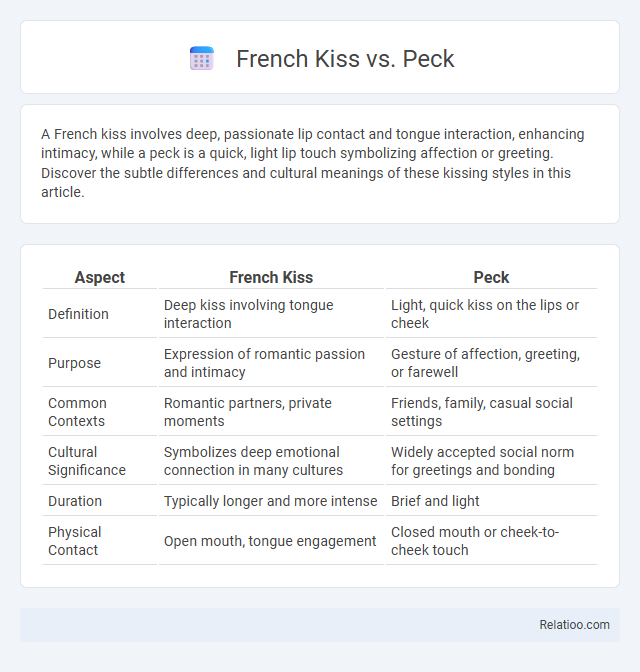A French kiss involves deep, passionate lip contact and tongue interaction, enhancing intimacy, while a peck is a quick, light lip touch symbolizing affection or greeting. Discover the subtle differences and cultural meanings of these kissing styles in this article.
Table of Comparison
| Aspect | French Kiss | Peck |
|---|---|---|
| Definition | Deep kiss involving tongue interaction | Light, quick kiss on the lips or cheek |
| Purpose | Expression of romantic passion and intimacy | Gesture of affection, greeting, or farewell |
| Common Contexts | Romantic partners, private moments | Friends, family, casual social settings |
| Cultural Significance | Symbolizes deep emotional connection in many cultures | Widely accepted social norm for greetings and bonding |
| Duration | Typically longer and more intense | Brief and light |
| Physical Contact | Open mouth, tongue engagement | Closed mouth or cheek-to-cheek touch |
Understanding the French Kiss: Definition and Origins
The French kiss involves deep, passionate lip contact with open mouths and tongue interaction, differentiating it from a simple peck or kiss that is brief and closed-mouthed. Originating from France in the early 20th century, the term highlights cultural associations with romance and sensuality. Understanding the French kiss helps you appreciate its intimate nature compared to other forms of kissing.
What is a Peck? A Quick Overview
A peck is a light, quick kiss typically placed on the cheek or lips, conveying affection or friendly greeting without deep intimacy. Unlike a French kiss, which involves open-mouth passion and tongue interaction, a peck is brief and non-sensual. It serves as a simple gesture of warmth, often used in casual or social settings.
Key Differences: French Kiss vs Peck
A French kiss involves deep, open-mouth contact with tongue engagement, creating a more intimate and passionate experience compared to a peck, which is a brief, closed-mouth kiss typically on the lips or cheek. The peck serves as a quick gesture of affection or greeting, lacking the sensual intensity and prolonged connection found in a French kiss. Understanding these distinctions highlights the varying levels of intimacy and emotional expression conveyed through each type of kiss.
Cultural Meanings of French Kissing and Pecking
French kissing often symbolizes deep passion and intimacy in Western cultures, conveying strong emotional connection beyond a simple gesture, while a peck usually signifies casual affection or informal greetings, such as between friends or family members. Your choice between a French kiss and a peck reflects cultural norms and the level of intimacy expected or accepted within different social contexts. Understanding these differences helps navigate personal boundaries and communicate feelings appropriately across diverse cultures.
When to French Kiss and When to Peck
A French kiss involves deep, intimate contact using tongue, typically reserved for moments of strong romantic connection or passion. A peck is a quick, light kiss, perfect for casual greetings or farewells without conveying intense emotion. Understanding when to French kiss or peck helps you communicate your feelings appropriately and respect personal boundaries in different social situations.
The Science of Kissing: Physical and Emotional Responses
The science of kissing reveals that French kisses trigger intense physical responses by activating more sensory receptors and increasing oxytocin levels, fostering deep emotional bonding. Peck kisses, being brief and light, produce a mild release of dopamine and serotonin, often signaling affection without high arousal. A regular kiss balances physical stimulation and emotional connection, engaging the brain's reward centers and promoting overall well-being through hormonal release.
First Date Etiquette: French Kiss or Peck?
On a first date, opting for a peck on the lips is considered more appropriate and respectful, signaling interest without overwhelming the other person. A French kiss, involving open-mouth contact and tongue, is typically reserved for a more established romantic connection after mutual comfort and consent are clearly established. Understanding these nuances in first date etiquette can set the right tone and foster positive impressions.
French Kiss vs Peck: Relationship Implications
A French kiss involves deeper intimacy and passion, often signaling a strong romantic connection and emotional closeness between partners. In contrast, a peck is a quick, light kiss that tends to convey affection or casual greeting without the same level of emotional intensity. Understanding the distinctions helps clarify relationship dynamics and emotional intent behind each gesture.
Tips for Perfecting Your Kiss
Mastering the nuances between a French kiss, peck, and traditional kiss involves understanding tongue use, pressure, and timing. For a perfect French kiss, maintain gentle, rhythmic movements with controlled tongue play to enhance intimacy without overwhelming your partner. In contrast, a peck requires a light, brief touch of the lips, ideal for casual affection, while a traditional kiss balances softness and passion, emphasizing connection through eye contact and synchronized breathing.
Common Myths About Kissing Styles
Common myths about kissing styles often confuse the meanings and implications of a French kiss, peck, and kiss. A French kiss, characterized by deep lip contact and tongue involvement, is frequently misrepresented as purely passionate or intimate, but it can also be a casual expression of affection. You should understand that a peck is a quick, light kiss often mistaken for lack of affection, while a kiss ranges widely in style and emotional significance, debunking the myth that kissing always conveys the same message across cultures.

Infographic: French Kiss vs Peck
 relatioo.com
relatioo.com